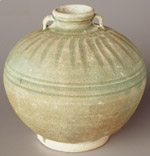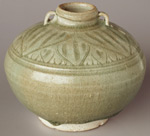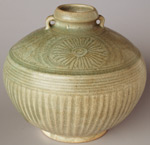
The Turiang shipwreck (+/- 1370)
Note the thin iron-rich glaze (early green glaze). The jar's spherical form shows no indication of foreign influence. Other green-glazed wares from this shipwreck are of similar style. The form is simple, and undecorated.
Note the thin iron-rich glaze (early green glaze). The jar's spherical form shows no indication of foreign influence. Other green-glazed wares from this shipwreck are of similar style. The form is simple, and undecorated.

By this time, the glaze is thicker, and properly reduced during firing. Form is improving, and is often compressed or globular. Decoration is limited to carved striations on the shoulder. Note the creamish clay: in later pieces this is finer, and grey in colour.

By this time forms are balanced and attractive. The celadon glaze is thick, bluish and transparent. Perfected potting technique and good firing control seem common. Incised lotus petals or 'onionskin' often decorate the shoulder, while the lower body remains undecorated. Other celadons from this site are of uniformly high quality.

This jar represents the peak of celadon production at Sisatchanalai. The matured glaze, flattened shoulder and compressed globular form are masterful. Decoration is exquisite, and includes vertical striations on the lower body. Favoured motifs include lotus flowers, leaves and chrysanthemums.
From
the collection of Mr Raj Kannan.